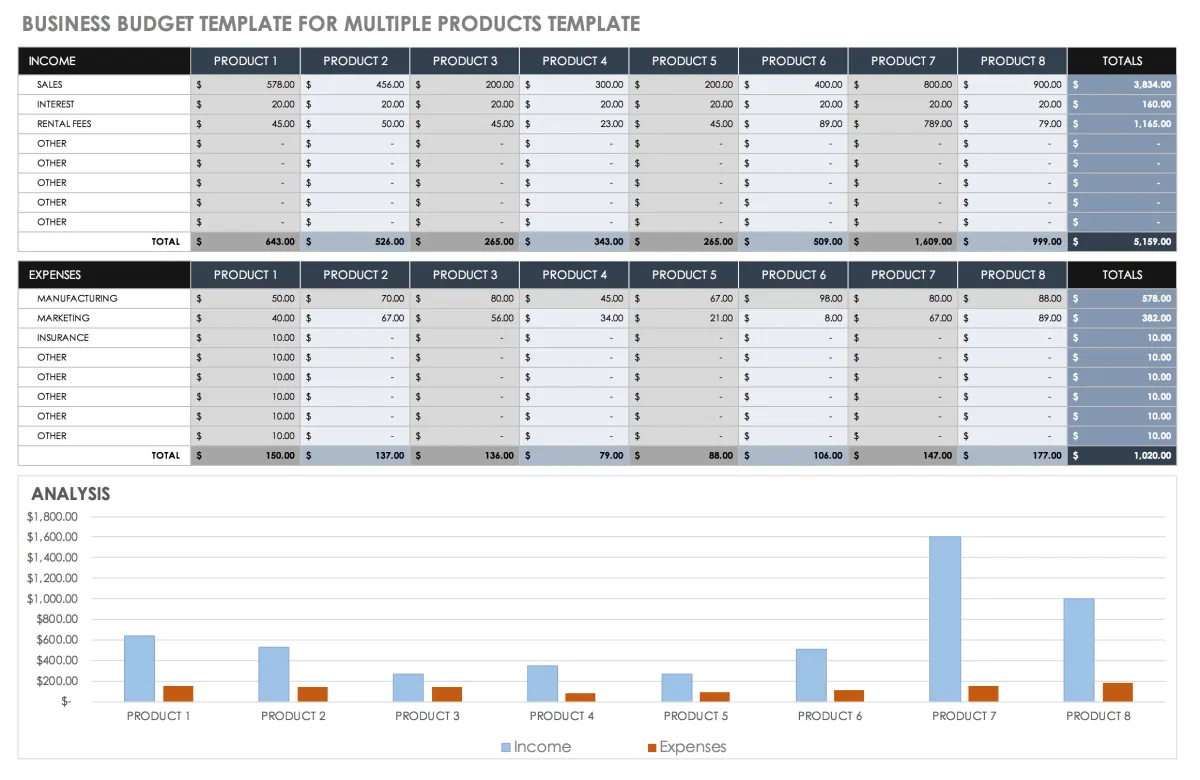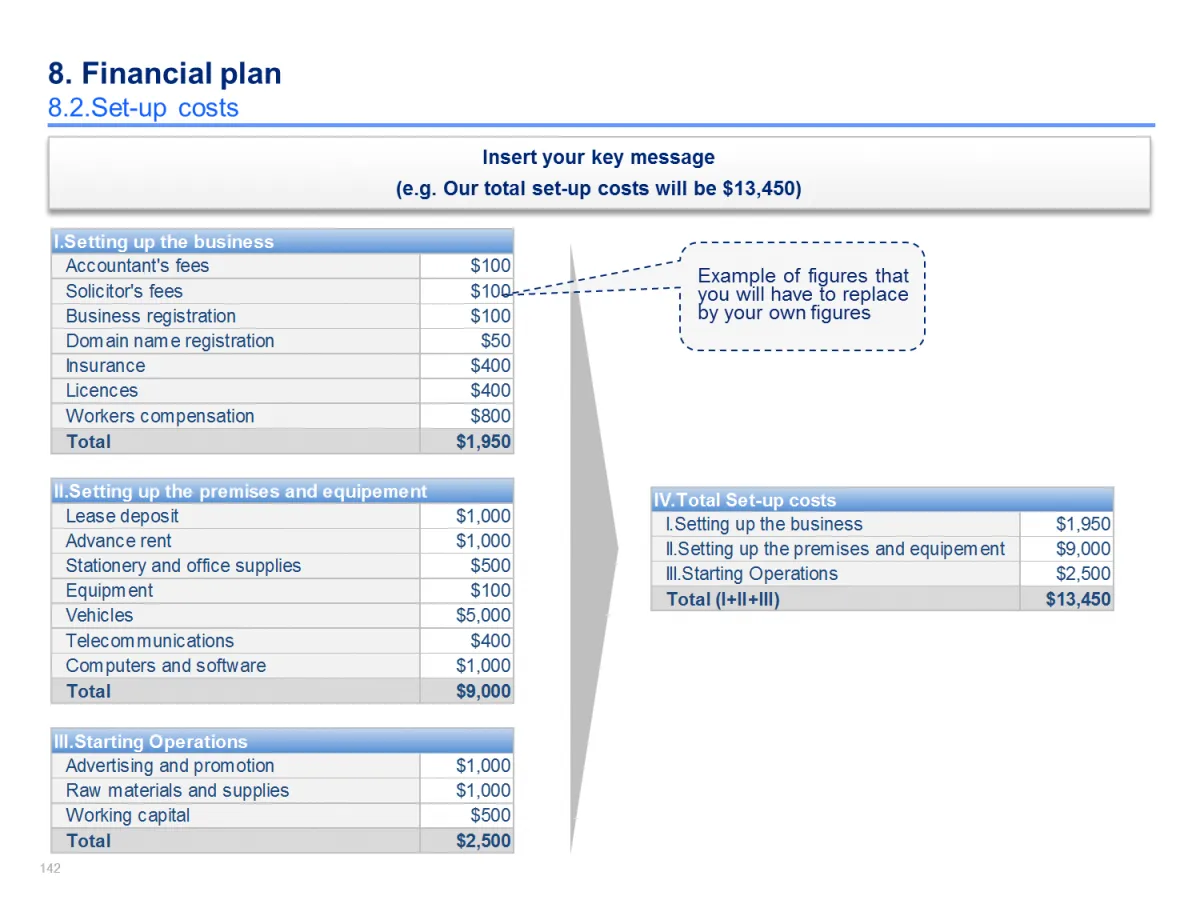Creating a solid financial plan is crucial for the success of your business. This article will guide you through the essential steps to establish a comprehensive financial strategy that ensures the growth and sustainability of your enterprise.
Importance of a Business Financial Plan
A business financial plan is more than just a document outlining your financial goals. It serves as a roadmap for your business’s financial future, guiding your decisions and increasing your chances of success. Here’s why it’s crucial:
1. Securing Funding
Whether you’re seeking funding from investors, lenders, or financial institutions, a comprehensive financial plan is non-negotiable. It demonstrates your business’s viability, growth potential, and ability to repay loans. A well-structured plan increases your credibility and persuasiveness in securing the necessary capital.
2. Strategic Decision Making
A financial plan provides valuable insights into your business’s financial health, allowing you to make informed decisions. It helps you analyze your revenue streams, expenses, and cash flow, enabling you to identify areas for improvement, cost optimization, and growth opportunities.
3. Measuring Progress and Performance
Think of your financial plan as a benchmark against which you can track your business’s performance. By comparing your actual results to your projections, you can identify any deviations, analyze their causes, and make necessary adjustments to stay on course.
4. Attracting and Retaining Talent
A solid financial plan can be a powerful tool for attracting and retaining top talent. It demonstrates stability, vision, and a clear path for the future, giving potential employees confidence in the company’s long-term prospects.
5. Mitigating Risks
Every business faces inherent risks. A financial plan helps you identify potential financial pitfalls and develop contingency strategies to mitigate their impact. By forecasting different scenarios, you can prepare for uncertainties and safeguard your business’s financial well-being.
Assessing Your Business’s Financial Situation

Before you can create a financial plan for your business, you need to take stock of where you are financially right now. This means gathering data, analyzing your financial history, and understanding your current financial health. This step is crucial as it forms the foundation of your financial plan. Here’s a breakdown of how to assess your business’s financial situation:
1. Gather Financial Information
Start by collecting key financial documents. This includes:
- Income Statement (Profit and Loss Statement): Shows your business’s revenues and expenses over a specific period.
- Balance Sheet: Provides a snapshot of your business’s assets, liabilities, and equity at a particular point in time.
- Cash Flow Statement: Tracks the flow of cash both into and out of your business.
2. Analyze Your Financial History
With your financial documents in hand, analyze your historical financial performance. Consider:
- Revenue Trends: Is your revenue growing, declining, or stagnant?
- Expense Analysis: Identify your largest expenses and look for areas to reduce costs.
- Profitability: How profitable has your business been? Are there any trends or red flags?
3. Calculate Key Financial Ratios
Financial ratios provide valuable insights into your business’s performance. Some essential ratios to calculate include:
- Liquidity Ratios: Measure your ability to meet short-term obligations (e.g., current ratio, quick ratio).
- Profitability Ratios: Evaluate your business’s efficiency in generating profits (e.g., gross profit margin, net profit margin).
- Solvency Ratios: Assess your long-term financial stability (e.g., debt-to-equity ratio).
4. Identify Strengths and Weaknesses
Based on your analysis, pinpoint your business’s financial strengths and weaknesses. What are you doing well financially? Where are there areas for improvement?
5. Consider External Factors
Don’t forget about external factors that could impact your business’s finances, such as:
- Economic Conditions: Is the economy growing or shrinking?
- Industry Trends: Are there any new trends or technologies impacting your industry?
- Competitive Landscape: Who are your competitors, and how do they compare financially?
Setting Financial Goals for Your Business
Setting clear and specific financial goals is the cornerstone of a successful financial plan. These goals provide a roadmap for your business’s financial future, guiding your decisions and actions. Without them, your financial plan is like a ship without a rudder, adrift in a sea of uncertainty.
Types of Financial Goals
Financial goals can vary depending on the nature and stage of your business. Some common types include:
- Revenue and Profitability Goals: These are fundamental and focus on generating income and ensuring profitability. Examples include target revenue figures, gross profit margins, and net income targets.
- Cash Flow Goals: Maintaining a healthy cash flow is crucial for operational stability. Goals might involve improving accounts receivable turnover, managing inventory efficiently, or securing lines of credit.
- Funding and Investment Goals: These relate to securing capital for growth or expansion. Examples include raising funds through investors, securing loans, or reinvesting profits back into the business.
- Debt Management Goals: If your business has debt, establishing goals for repayment or restructuring is essential. This could involve reducing debt-to-equity ratios or refinancing existing loans.
- Exit Strategy Goals: Thinking ahead to the future of your business is vital. This could involve setting goals for a potential sale, merger, or succession plan, and determining the financial targets necessary to achieve them.
SMART Goals for Financial Success
To ensure your financial goals are effective, they should be SMART:
- Specific: Clearly define what you want to achieve. Instead of “increase revenue,” aim for “increase revenue by 15% in the next fiscal year.”
- Measurable: Use quantifiable metrics to track progress. “Reduce operating expenses” is too vague; aim to “reduce operating expenses by 5%.”
- Achievable: Set realistic goals within your business’s capabilities. While ambitious targets are good, they should be grounded in feasibility.
- Relevant: Ensure goals align with your overall business objectives. If expansion is a priority, your financial goals should support that strategy.
- Time-Bound: Establish deadlines for goal achievement to create urgency and accountability. For example, “reach a 20% profit margin within two years.”
Budgeting for Business Expenses

Creating a detailed budget for business expenses is a crucial step in developing a sound financial plan. This involves identifying, categorizing, and forecasting all costs associated with running your business. An accurate expense budget helps you monitor cash flow, allocate resources effectively, and make informed financial decisions.
Steps for Budgeting Business Expenses:
- Identify All Expenses: Start by listing every expense your business incurs, both fixed and variable. This includes:
- Fixed Costs: Rent, salaries, insurance, loan payments.
- Variable Costs: Raw materials, utilities, marketing expenses.
- One-time Expenses: Equipment purchases, website development.
- Categorize Expenses: Group similar expenses into categories for easier analysis. Common expense categories include:
- Cost of Goods Sold (COGS)
- Marketing & Sales
- Rent & Utilities
- Salaries & Benefits
- Administrative & General
- Estimate Costs: Research and gather historical data to estimate the cost of each expense category. Use industry benchmarks and past financial statements to make accurate projections.
- Project Future Expenses: Forecast your expenses for the budget period, considering factors like business growth, inflation, and seasonal fluctuations.
- Track and Review Regularly: Monitor your actual expenses against your budget regularly. Analyze variances and identify areas where adjustments may be needed.
Tips for Effective Expense Budgeting:
- Use budgeting software or spreadsheets for organization and calculations.
- Be realistic and conservative in your expense estimations.
- Factor in a contingency buffer for unexpected costs.
- Involve key personnel in the budgeting process.
Financial Forecasting and Projections
Financial forecasting is a crucial aspect of your business plan. It involves predicting your business’s future financial performance based on historical data, industry trends, and market conditions. Accurate forecasting helps you make informed decisions, secure funding, and track your progress toward your financial goals.
Key Financial Projections:
- Revenue Projections: Estimate your future sales revenue by considering factors like market demand, pricing strategies, and sales and marketing efforts.
- Cost of Goods Sold (COGS): Project the direct costs associated with producing your goods or services, including raw materials, labor, and manufacturing overhead.
- Operating Expenses: Forecast your operating expenses, such as rent, utilities, salaries, marketing, and administrative costs.
- Cash Flow Projections: Anticipate the inflow and outflow of cash in your business, taking into account sales, expenses, investments, and financing activities.
- Profit and Loss (P&L) Statement: Project your expected profits or losses over a specific period by considering projected revenues, COGS, and operating expenses.
- Balance Sheet: Forecast your business’s assets, liabilities, and equity at a specific point in time, providing a snapshot of its financial health.
Methods for Financial Forecasting:
- Time-Series Analysis: Use historical data to identify trends and patterns that can help predict future performance.
- Regression Analysis: Determine the relationship between different variables (e.g., marketing spend and sales) to forecast future outcomes.
- Qualitative Forecasting: Incorporate expert opinions, market research, and industry insights to make informed projections.
Remember that financial forecasting is not an exact science but an ongoing process. Regularly review and adjust your projections as new information becomes available. The accuracy of your forecasts depends on the quality of your data and your understanding of the factors influencing your business.
Managing Cash Flow

Managing cash flow is crucial for the survival and growth of your business. It involves tracking the money coming into and going out of your business and making strategic decisions to ensure you have enough cash on hand to meet your financial obligations and fuel growth.
Here are key aspects of managing cash flow within your financial plan:
1. Cash Flow Forecasting
Accurately forecasting your cash flow is essential. This involves projecting your future cash inflows and outflows, allowing you to anticipate surpluses and shortfalls. Utilize historical data, sales projections, and industry trends to create realistic forecasts.
2. Optimizing Cash Inflows
Focus on strategies to accelerate cash inflows. This might include:
- Invoicing promptly and efficiently
- Offering discounts for early payments
- Exploring invoice factoring or financing options
- Diversifying revenue streams
3. Controlling Cash Outflows
Just as important as maximizing inflows is carefully managing your expenses. Strategies for controlling outflows include:
- Negotiating favorable terms with suppliers
- Cutting unnecessary expenses
- Taking advantage of early payment discounts from vendors
- Carefully timing major purchases or investments
4. Establishing a Cash Reserve
Unexpected expenses and economic downturns are inevitable. A healthy cash reserve acts as a safety net, allowing your business to navigate challenging times without derailing your financial stability. Aim to build a reserve that can cover 3-6 months of operating expenses.
5. Regularly Reviewing and Adjusting
Your financial plan is a living document. Regularly review your cash flow projections against actual performance. Identify variances, analyze the reasons behind them, and make necessary adjustments to your plan.
Securing Business Funding
A comprehensive financial plan is crucial not only for guiding your business’s growth but also for attracting potential investors and securing funding. Here’s how your financial plan plays a key role in securing business funding:
Demonstrating Viability
Investors and lenders need assurance that their investment is justified. Your financial plan provides this assurance by:
- Showcasing Revenue Projections: Realistic and well-supported revenue forecasts demonstrate the earning potential of your business.
- Outlining Expense Management: A clear picture of your planned expenses indicates your understanding of cost control and profitability.
- Presenting Cash Flow Analysis: A healthy cash flow projection assures lenders and investors of your ability to repay debts and generate returns.
Building Trust and Credibility
A detailed financial plan reflects positively on your business acumen and professionalism. It shows potential funders that:
- You are organized and strategic: A thorough plan demonstrates your commitment to long-term success, not just short-term gains.
- You understand your market: Market analysis and competitor research within your plan showcase your industry knowledge.
- You are prepared for challenges: Including risk assessments and contingency planning builds confidence in your ability to navigate obstacles.
Guiding Funding Requests
Your financial plan is the foundation for determining and justifying your funding needs. It helps you:
- Specify the Funding Amount: Clearly state how much funding you require based on your financial projections.
- Justify the Use of Funds: Detail how the funding will be allocated (e.g., inventory, marketing, equipment) and its projected impact on your business growth.
- Negotiate Loan Terms or Equity Stakes: Having concrete financial data empowers you to negotiate favorable terms with lenders or investors.
Reviewing and Updating Your Plan

Creating a financial plan isn’t a “set it and forget it” task. Your business is constantly evolving, and your financial plan needs to keep pace. Regularly reviewing and updating your plan is crucial for its continued relevance and effectiveness.
How Often Should You Review Your Plan?
Aim for at least an annual review, coinciding with the start of a new fiscal year. However, more frequent reviews might be necessary, especially during periods of significant change or uncertainty. Some triggers for review include:
- Significant changes in market conditions
- New product or service launches
- Unexpected expenses or revenue shortfalls
- New funding secured or changes in your capital structure
What to Consider During the Review:
During your review, evaluate the following aspects of your financial plan:
- Revenue and Expenses: Compare your projected figures against your actual performance. Identify any significant variances and investigate the reasons behind them.
- Cash Flow: Assess your cash flow projections and determine if you’ve maintained adequate liquidity. Are you on track to meet your short-term and long-term financial obligations?
- Key Performance Indicators (KPIs): Track the progress of your KPIs. Are you hitting your targets? If not, what adjustments need to be made to your strategies?
- Market Conditions: Have there been any significant changes in your industry or the overall economy? How might these changes impact your business in the coming year?
- Financial Goals: Review your long-term financial objectives. Are they still relevant and achievable? Do your financial projections support your ability to meet these goals?
Making Adjustments:
Based on your review, you might need to make adjustments to your plan. This could involve:
- Revising your revenue and expense projections
- Adjusting your pricing strategies
- Exploring new funding options
- Re-evaluating your operational expenses
- Modifying your long-term goals
Conclusion
In conclusion, creating a comprehensive financial plan is essential for the success and sustainability of your business, providing a roadmap for managing funds effectively and achieving your financial goals.

